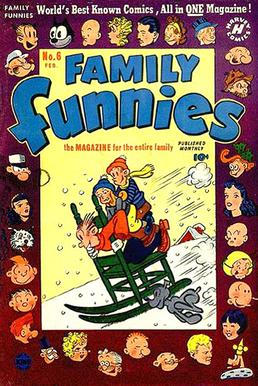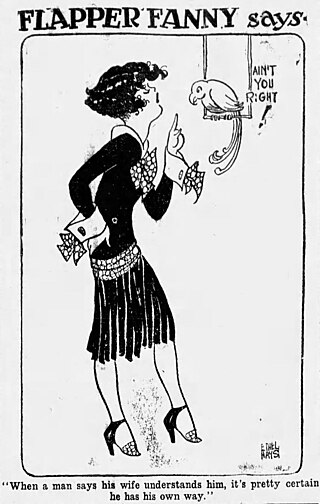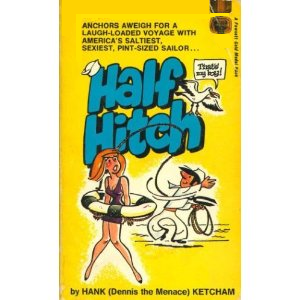Cast
- Morty Meekle – office worker
- Jill Wortle – Morty's girlfriend
- Mr. and Mrs. Wortle – Jill's parents
- Winthrop Wortle – Jill's kid brother
- E. G. Boomer – Morty's boss
| Morty Meekle | |
|---|---|
| Author(s) | Dick Cavalli |
| Current status/schedule | Concluded daily & Sunday strip |
| Launch date | January 9, 1956 [1] |
| End date | February 26, 1966 |
| Alternate name(s) | Morty Meekle and Winthrop |
| Syndicate(s) | Newspaper Enterprise Association |
| Genre(s) | comedy, gag-a-day |
| Followed by | Winthrop |
Morty Meekle is an American syndicated newspaper comic strip that was published between 1956 and 1966, created and produced by cartoonist Dick Cavalli. The series featured the title character dealing with office and dating situations, and, like Fritzi Ritz , which became Nancy after sixteen years, evolved to focus on the younger characters from Cavalli's strip, and was renamed Morty Meekle and Winthrop and then just Winthrop on February 27, 1966. [2]
Gag cartoonist Dick Cavalli—whose work appeared in magazines including The Saturday Evening Post and Collier's —had achieved such popularity by 1956 that Writer's Digest observed he had "risen to the top faster than any other cartoonist in the business." [3] On January 9 of that year, Cavalli launched Newspaper Enterprise Association's syndicated comic strip Morty Meekle, featuring the courtship of the title character and his girlfriend, Jill Wortle, as well as Morty's travails at his low-level office job under boss E.G. Boomer. [4] The strip gradually deemphasized the romance and work aspects in favor of what comics historian Maurice Horn called its "background chorus of snide youngsters with a perceptive take on the human condition." [3] On February 27, 1966, Cavalli removed the adult characters and renamed the strip Winthrop, after Jill's kid brother, the most prominent of the young social critics. [3] [4]

The Katzenjammer Kids is an American comic strip created by Rudolph Dirks in 1897 and later drawn by Harold Knerr for 35 years. It debuted on December 12, 1897, in the American Humorist, the Sunday supplement of William Randolph Hearst's New York Journal. The comic strip was turned into a stage play in 1903. It inspired several animated cartoons and was one of 20 strips included in the Comic Strip Classics series of U.S. commemorative postage stamps.

Melvin Lazarus was an American cartoonist, best known as the creator of two comic strips, Miss Peach (1957–2002) and Momma (1970–2016). Additionally, he wrote two novels. For his comic strip Pauline McPeril, he used the pseudonym Fulton, which is also the name of a character in his first novel, The Boss Is Crazy, Too.

Miss Peach was a syndicated comic strip created by American cartoonist Mell Lazarus. It ran for 45 years, from February 4, 1957, to September 8, 2002.

The Born Loser is a newspaper comic strip created by Art Sansom in 1965. His son, Chip Sansom, who started assisting on the strip in 1989, is the current artist. The strip is distributed by Newspaper Enterprise Association. The Sansoms won the 1987 National Cartoonists Society Humor Comic Strip Award and the 1990 Newspaper Comic Strip Award.
United Feature Syndicate, Inc. (UFS) is a large American editorial column and comic strip newspaper syndication service based in the United States and established in 1919. Originally part of E. W. Scripps Company, it was part of United Media from 1978 to 2011, and is now a division of Andrews McMeel Syndication. United Features has syndicated many notable comic strips, including Peanuts, Garfield, Li'l Abner, Dilbert, Nancy, and Marmaduke.

The Newspaper Enterprise Association (NEA) is an editorial column and comic strip newspaper syndication service based in the United States and established in 1902. The oldest syndicate still in operation, the NEA was originally a secondary news service to the Scripps Howard News Service; it later evolved into a general syndicate best known for syndicating the comic strips Alley Oop, Our Boarding House, Freckles and His Friends, The Born Loser, Frank and Ernest, and Captain Easy / Wash Tubbs; in addition to an annual Christmas comic strip. Along with United Feature Syndicate, the NEA was part of United Media from 1978 to 2011, and is now a division of Andrews McMeel Syndication. The NEA once selected college All-America teams, and presented awards in professional football and professional [NBA] basketball.

Apartment 3-G is an American newspaper soap opera comic strip about a trio of career women who share an apartment in Manhattan. Created by Nicholas P. Dallis with art by Alex Kotzky, the strip began May 8, 1961, initially distributed by the Publishers Syndicate, which later merged with King Features Syndicate in 1988.

Smitty was a newspaper comic strip created in the early 1920s by Walter Berndt. Syndicated nationally by the Chicago Tribune New York News Syndicate, it ran from November 27, 1922, to 1974 and brought Berndt a Reuben Award in 1969.

Mickey Finn was an American comic strip created by cartoonist Lank Leonard, which was syndicated to newspapers from April 6, 1936 to September 10, 1977. The successful lighthearted strip struck a balance between comedy and drama. It was adapted to a 400-page Little Big Book and was reprinted in several comic book series throughout the 1930s and 1940s.

Toots and Casper is a family comic strip by Jimmy Murphy, distributed to newspapers for 38 years by King Features Syndicate, from December 17, 1918 to December 30, 1956. The strip spawned many merchandising tie-ins, including books, dolls, paper dolls, pins, bisque nodders and comic books.
This is a timeline of significant events in comics in the 1910s.
This is a timeline of significant events in comics in the 1900s.

Barney Baxter in the Air is an American comic strip by Frank Miller. It started its run on September 30, 1935, for the Denver's Rocky Mountain News. Starting on December 7, 1936, it was syndicated by King Features. Barney Baxter was an "adventure strip" involving heroic exploits centering on aviation.

Flapper Fanny Says was a single-panel daily cartoon series starting on January 26, 1925, with a Sunday page following on August 7, 1932. Created by Ethel Hays, each episode featured a flapper illustration and a witticism. The Sunday strip concluded on December 8, 1935; the daily panel continued until June 29, 1940.

Half Hitch is an American comic strip by Hank Ketcham, in syndication first between 1943 and 1945 and later from 1970 to 1975. It is an example of military humor, but unlike most cartoons and comics of this genre, is focused on the navy, rather than the army. The unnamed character first appeared in The Saturday Evening Post in 1943.
Bob Weber, Sr., was an American cartoonist, best known for his Moose and Molly comic strip, distributed by King Features Syndicate.
Quincy is an American syndicated newspaper comic strip published from July 13, 1970 to October 4, 1986, created and produced by cartoonist Ted Shearer. The series, about an African-American boy being raised by his grandmother in Harlem, was one of the earliest mainstream comic strips to star an African American in the lead role, following Dateline: Danger! (1968-1974) and Luther (1969-1986). Another predecessor, Wee Pals, features an African-American among an ensemble cast of different races and ethnicities.
Winthrop is an American syndicated newspaper comic strip that was published between 1966 and 1994, created and produced by cartoonist Dick Cavalli. The series—which derived its comedy from a group of children's nonchalantly world-wise observations—evolved from Cavalli's 1956-1966 strip, Morty Meekle, which featured adult characters.
Richard A. Cavalli was an American commercial illustrator and cartoonist best known for the comic strips Morty Meekle and its successor, Winthrop, which consecutively were syndicated to newspapers from 1956 to 1994.
The New York World was one of the first newspapers to publish comic strips, starting around 1890, and contributed greatly to the development of the American comic strip. Notable strips that originated with the World included Richard F. Outcault's Hogan's Alley, Rudolph Dirks' The Captain and the Kids, Denys Wortman's Everyday Movies, Fritzi Ritz, Gus Mager's Hawkshaw the Detective, Victor Forsythe's Joe Jinks, and Robert Moore Brinkerhoff's Little Mary Mixup.